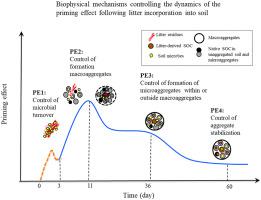Soil Biology and Biochemistry ( IF 9.8 ) Pub Date : 2020-10-05 , DOI: 10.1016/j.soilbio.2020.108039 Kai Liu , Yuzhi Xu , Wenting Feng , Xianfeng Zhang , Shuihong Yao , Bin Zhang

|
Incorporating plant litter into soil can replenish soil organic carbon (SOC) through physical protection mechanisms, such as formation of mineral-organic complexes and aggregates. Meanwhile, plant litter input may stimulate the decomposition of native SOC, known as the priming effect. It remains unclear how these physical protection mechanisms affect the priming effect, which further affects the SOC dynamics. Here, we present a novel model that can predict the dynamics of protected and primed organic carbon in soil and aggregates (PROCAAS). The PROCAAS model assumes that microbial activity will control the dynamics of both aggregate turnover and the priming effect following litter incorporation, and that litter-derived SOC will prime the decomposition of the native SOC pool as they are in the same location and in the same pool, either occluded in soil pores or associated with minerals. The PROCAAS model was well calibrated and validated using independent datasets of aggregate mass proportion and aggregated SOC contents in literature as well as soil respiration and the priming effect measured here during 76-day incubation with and without 13C labeled litter. The model results showed that litter-derived SOC was protected predominantly through occlusion in macroaggregates, while the priming effect was originated mainly from mineral-associated SOC in macroaggregates. The dynamics of priming effect could be explained by the soil structural change from soil disaggregation during litter incorporation, via the formations of macroaggregates and microaggregates within macroaggregates, to the aggregate stability during litter decomposition. Our proof-of-concept model can form the base for incorporating these biophysical mechanisms underlying soil aggregation and the priming effect into future ecosystem models.
中文翻译:

引入凋落物后恒定土壤湿度下土壤和团聚体中受保护的和灌注的有机碳的动力学模型
将植物凋落物掺入土壤可以通过物理保护机制(例如形成矿物-有机复合物和聚集体)来补充土壤有机碳(SOC)。同时,植物凋落物的输入可能会刺激天然SOC的分解,这称为启动效应。尚不清楚这些物理保护机制如何影响启动效应,进而进一步影响SOC动态。在这里,我们提出了一个新颖的模型,该模型可以预测土壤和团聚体中保护和引发有机碳的动力学(PROCAAS)。PROCAAS模型假设微生物活动将控制总周转的动态以及凋落物掺入后的启动效应,并且源自凋落物的SOC将在同一位置和同一池中引发天然SOC库的分解。 ,堵塞在土壤孔隙中或与矿物质有关。PROCAAS模型已使用文献中的总质量比例和总SOC含量以及土壤呼吸作用的独立数据集进行了很好的校准和验证,并在有和没有13C标记凋落物的情况下,在76天的孵化过程中测量了土壤呼吸作用和引发作用。模型结果表明,凋落物来源的SOC主要通过大团聚体的闭塞得到保护,而引发作用主要源自大团聚体中与矿物相关的SOC。引发效应的动力学可以通过土壤结构的变化来解释,从凋落物掺入过程中的土壤分解,到宏观聚集体中大颗粒聚集体和微聚集体的形成,到凋落物分解过程中聚集体的稳定性。











































 京公网安备 11010802027423号
京公网安备 11010802027423号